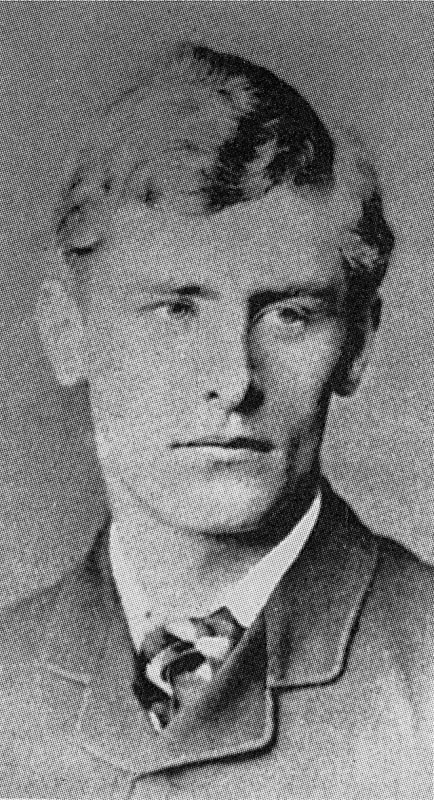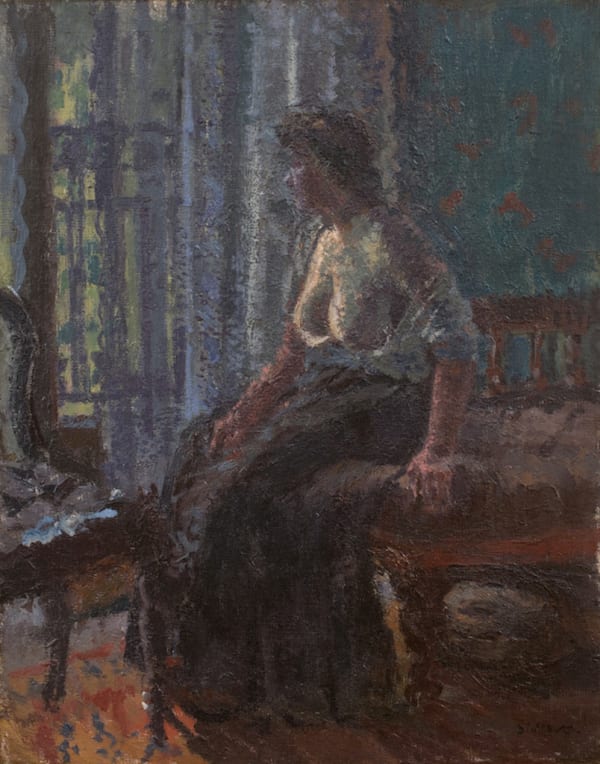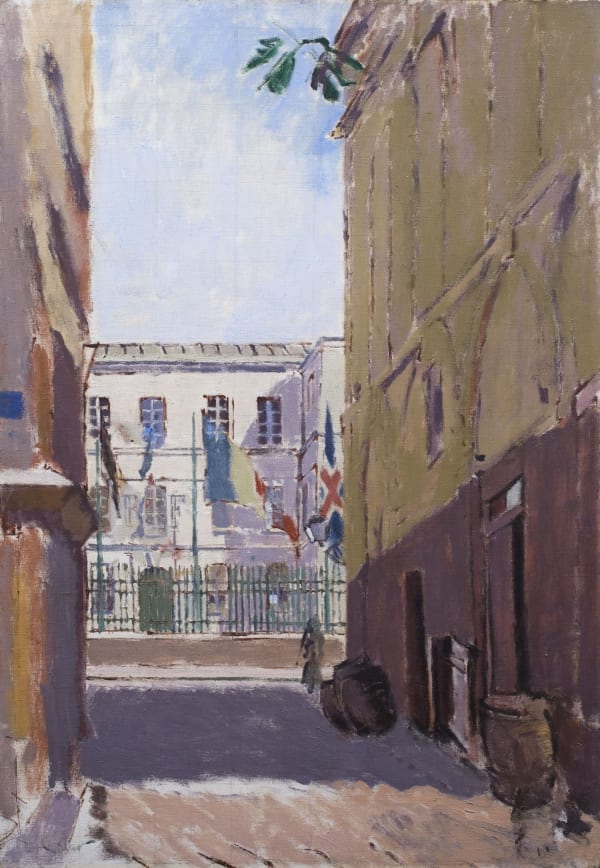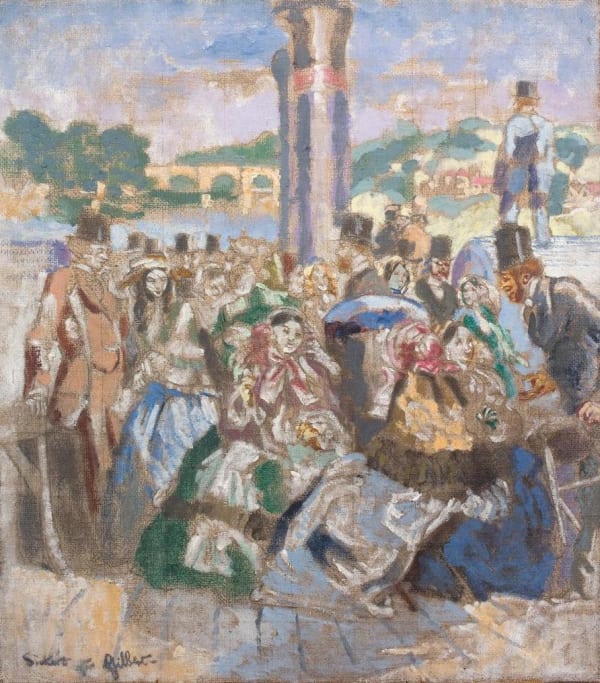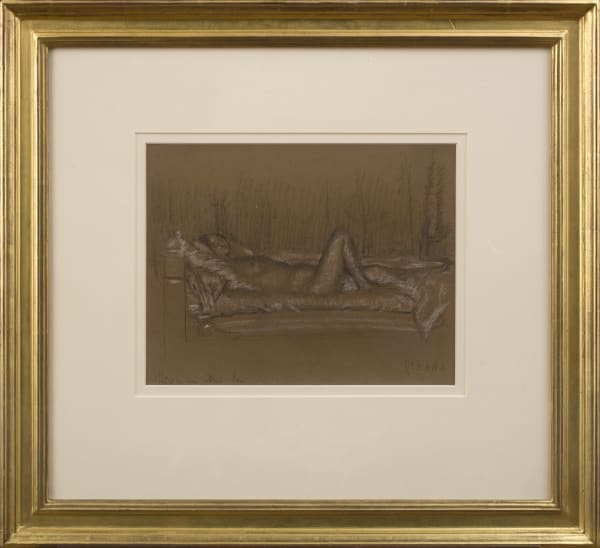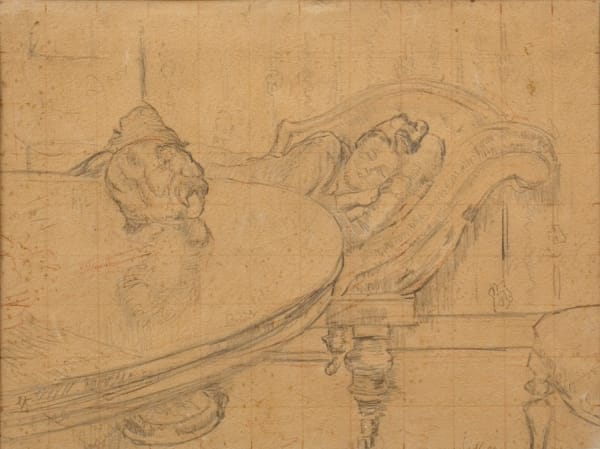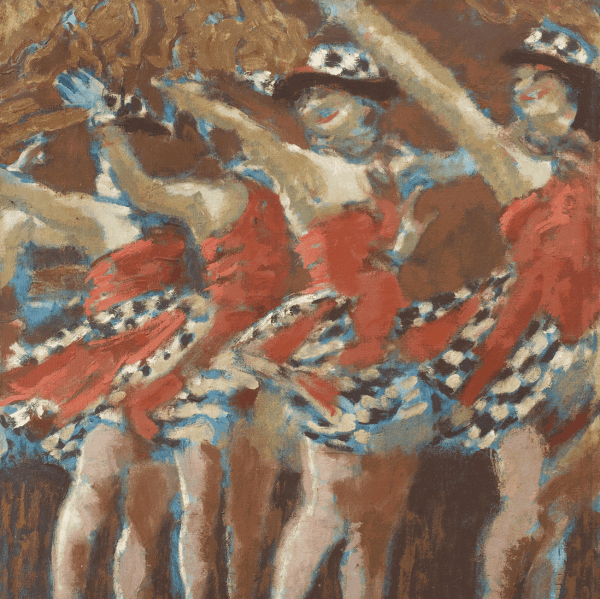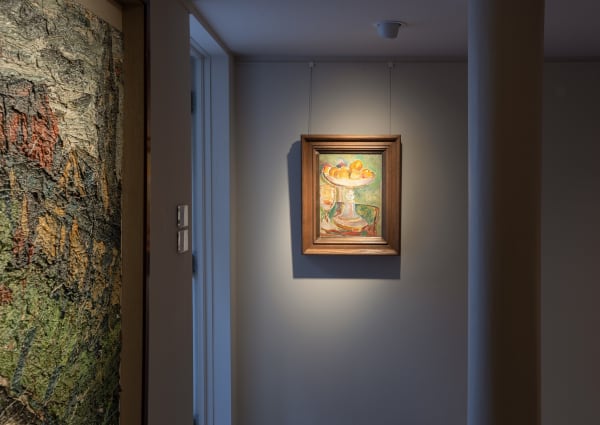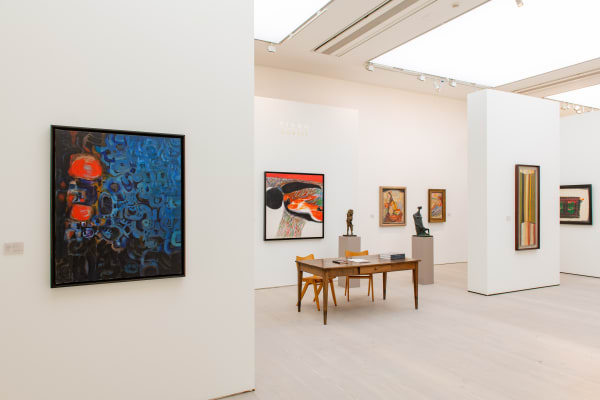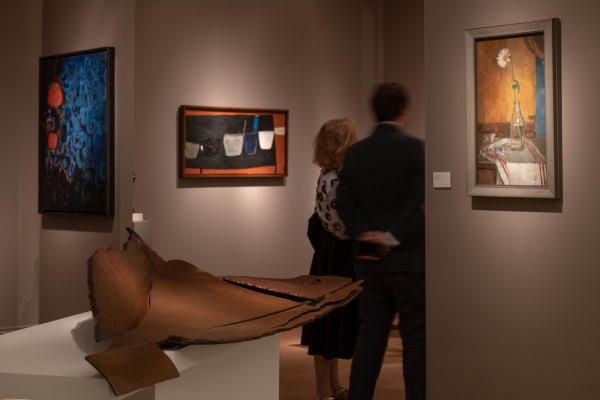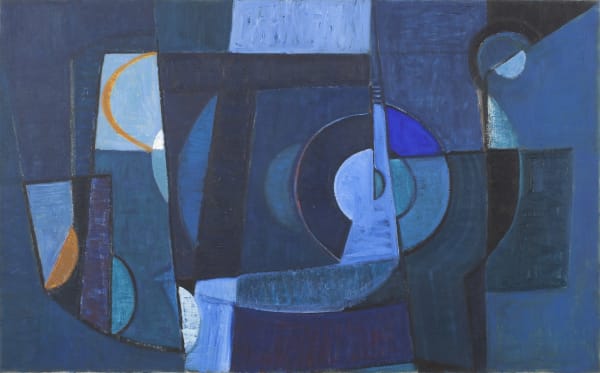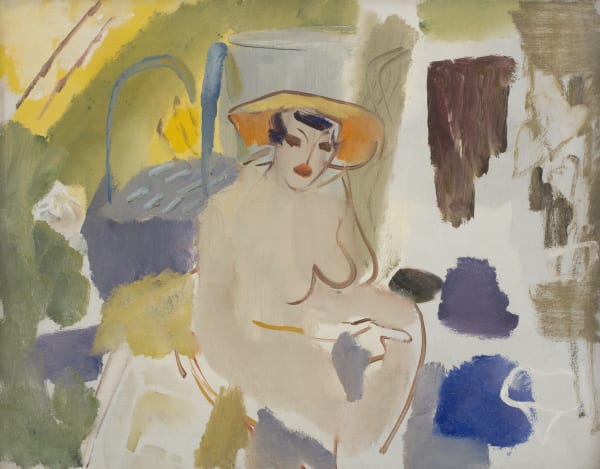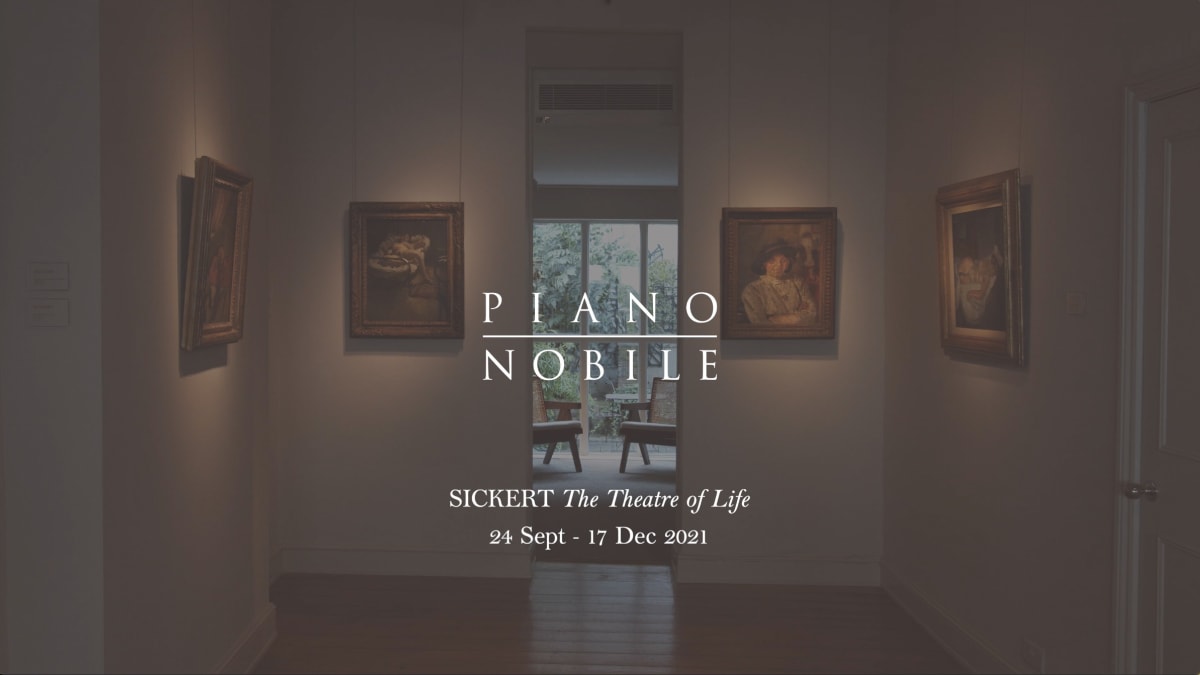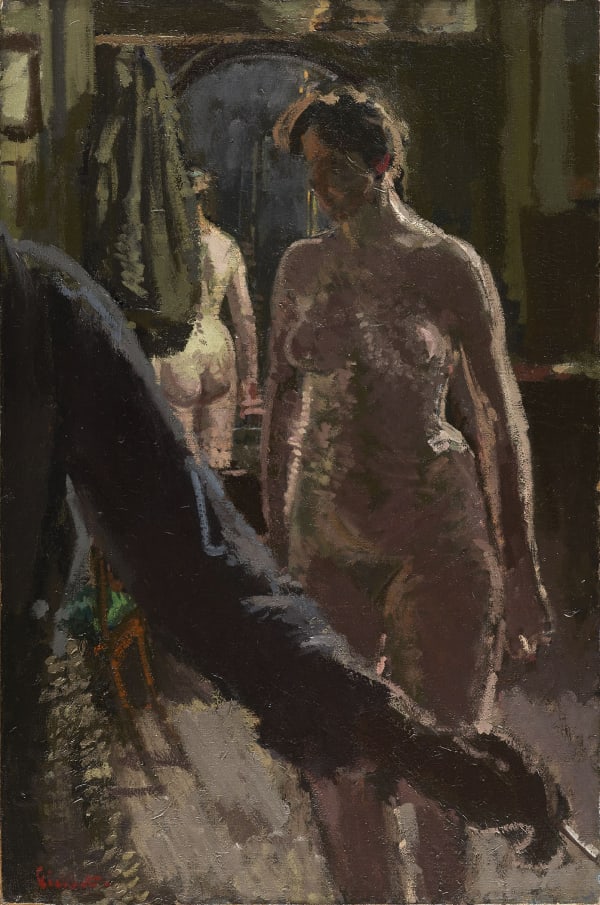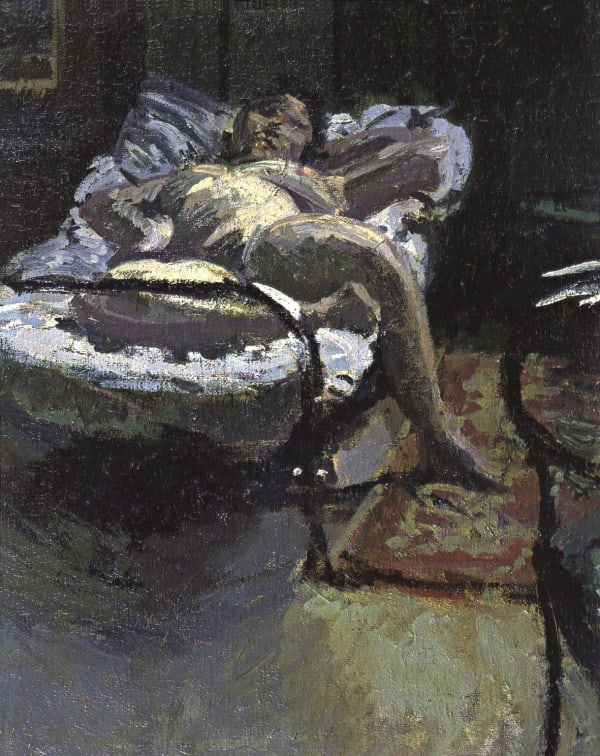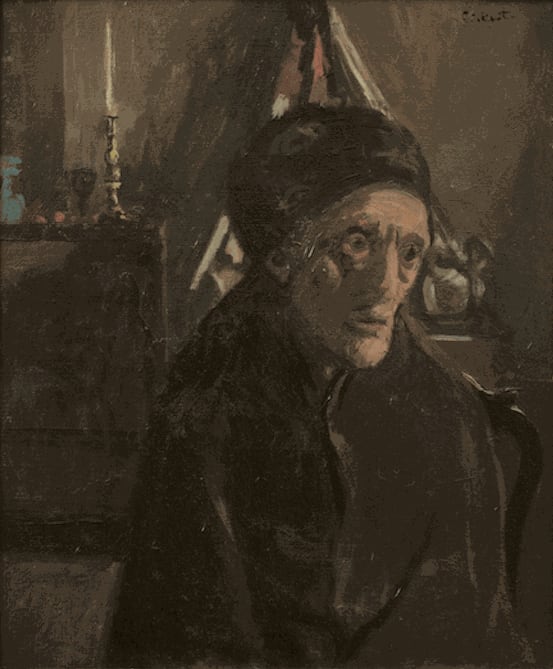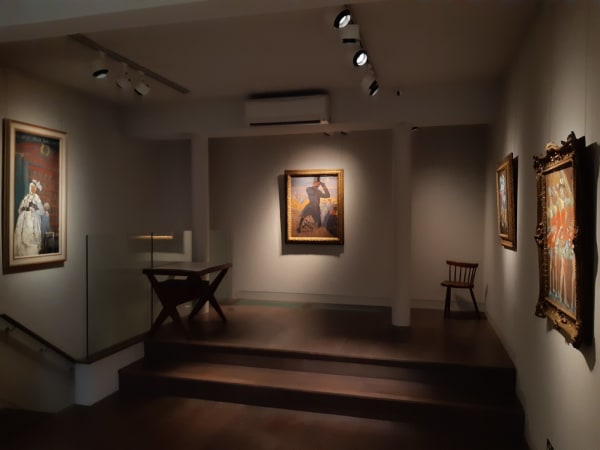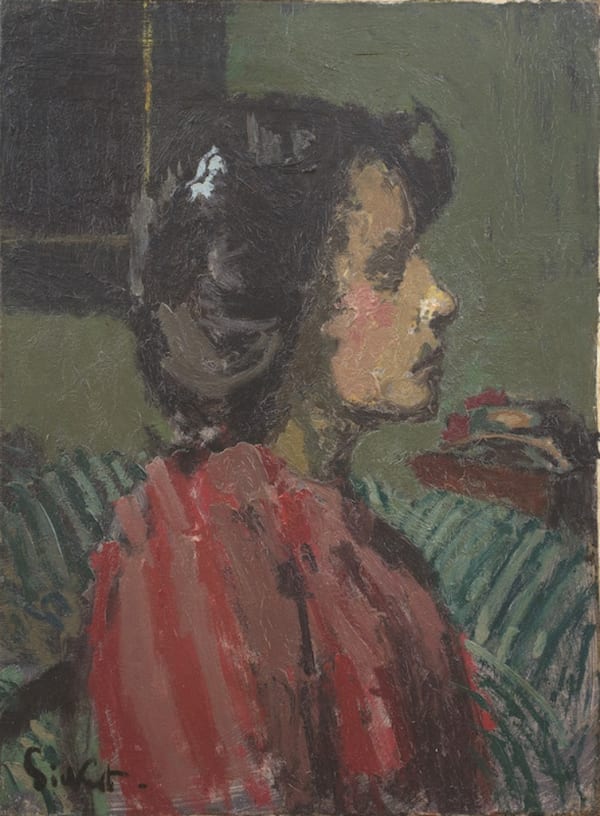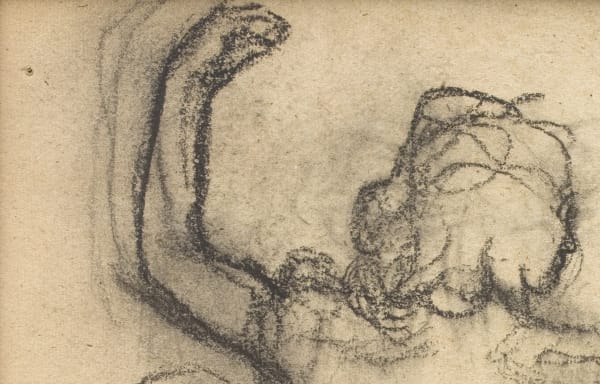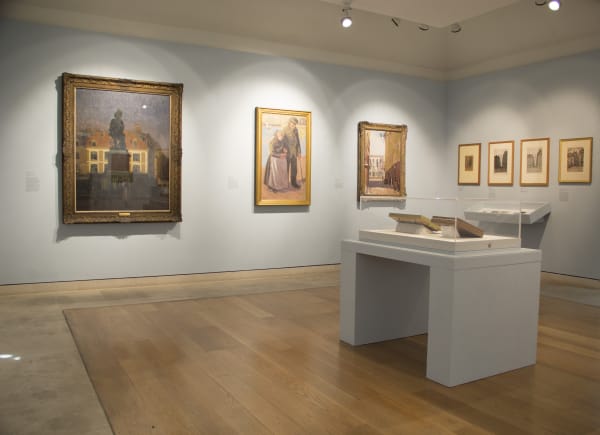Walter Sickert
The gallery regularly handles, acquires and advises on works by Walter Sickert. For more information or the availability of work, please contact the gallery.
Walter Sickert (1860 - 1942)
Born in Munich, of Danish and Anglo-Irish descent, Walter Sickert came to England from Dieppe in 1868 and remained cosmopolitan all his life. Classically educated, he spent some years in repertory theatre (1878-81), then attended the Slade School, London (1881-2), and worked in Whistler's studio, learning Etching and a characteristic subtlety of tonal painting. Between 1883 and 1885 he was in close contact with Degas and the Post-Impressionists, in Paris and Dieppe. In Venice from 1895, he returned to England in 1905, becoming the main link between English and continental painting. His north London studios became the centre for several artistic groups, including the Camden Town Group and the London Group; a member of the New English Art Club from 1888, he became ARA in 1924 and RA in 1934, although he resigned in 1935. He was an inspired teacher at Westminster Art School until 1918, and thereafter at various short-lived establishments of his own. Unsystematic but articulate in his theories of art, he gained a reputation as critic and commentator and his writings were published posthumously in A Free House! (1947), edited by Osbert Sitwell.
Eclectic and highly personal, Sickert's style changed throughout his career: the low-toned naturalism of his Camden Town period (La Hollandaise, 1906; Ennui, 1914; both London, Tate); the free impressionism of his architectural studies in Venice, Dieppe, and Bath; the bright lights and strange angles of his music hall paintings; and his late works, frequently based on photographs, light in colour with a drier, broader touch. A self-declared maverick, fascinated by all aspects of human life and emotion, he stands at the beginning of the modern movement in British art; a crucial influence on his own and subsequent generations.
Text Source: The Oxford Companion to Western Art
-
 Fruit under a Glass Dome, 1920-22
Fruit under a Glass Dome, 1920-22 -
 Woman Seated at a Window, 1908-9, c.
Woman Seated at a Window, 1908-9, c. -
 The Bridge, Chagford, 1916
The Bridge, Chagford, 1916 -
 Celebrations, Dieppe, 1914
Celebrations, Dieppe, 1914 -
 Mother and Daughter: Lou Lou I Love You, 1911
Mother and Daughter: Lou Lou I Love You, 1911 -
 Portrait of Mrs Barrett, 1906
Portrait of Mrs Barrett, 1906 -
 St Rémy: Chevet de l'Eglise, 1913
St Rémy: Chevet de l'Eglise, 1913 -
 The River [After John Gilbert], 1930-31, c.
The River [After John Gilbert], 1930-31, c. -
 The Studio: The Painting of a Nude, 1906
The Studio: The Painting of a Nude, 1906 -
 Vernet's Dance Hall, 1920
Vernet's Dance Hall, 1920 -
 Cicely Hey, 1923
Cicely Hey, 1923 -
 Hôtel du Quai Voltaire, Paris, 1906, c.
Hôtel du Quai Voltaire, Paris, 1906, c. -
 Study for Resting: The Napoleon III Tobacco Jar, 1916, c.
Study for Resting: The Napoleon III Tobacco Jar, 1916, c.
-
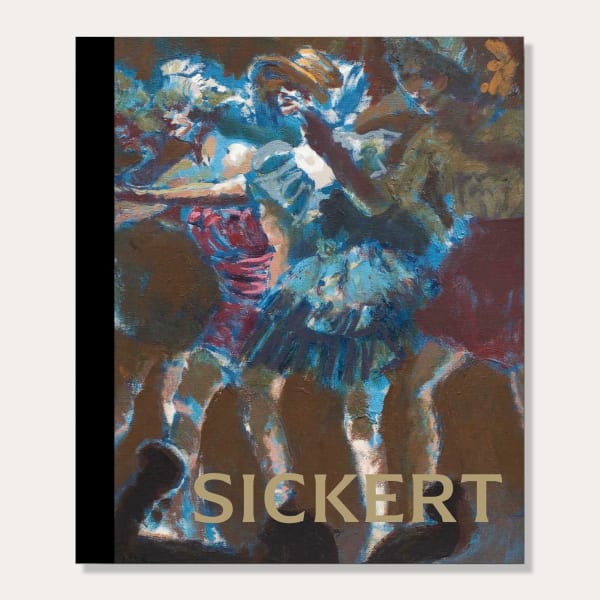
Sickert: The Theatre of Life
Wendy Baron, Richard Shone, Luke Farey, 2021 Read more -

Sickert: La provocation et l'énigme
Delphine Levy (Author), Wendy Baron (Preface), 2021Hardback, 573 pagesRead more
Publisher: Cohen and Cohen
ISBN: 978-2367490830
Dimensions: 27.4 x 31 x 5cm -
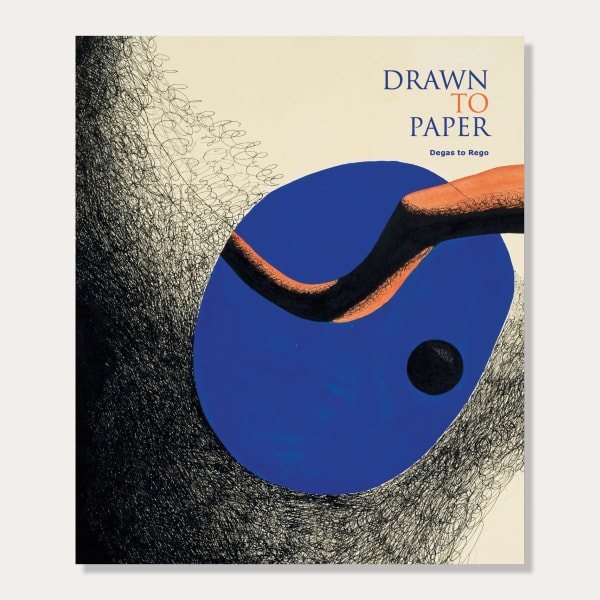
Drawn to Paper
Degas to Rego Piano Nobile, 2020softback, 40 pagesRead more
Publisher: Piano Nobile Publications
ISBN: 978-1-901192-58-2
Dimensions: 28 x 24cm -
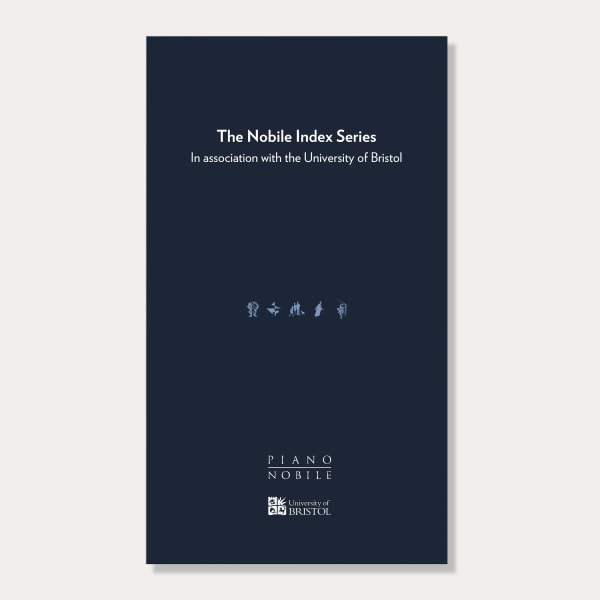
The Nobile Index Series
Box Set Various, 2017Box SetRead more
Publisher: Piano Nobile Publications
ISBN: 978-1-901192-49-0
Dimensions: 28.4 x 16.4 x 4.7cm -
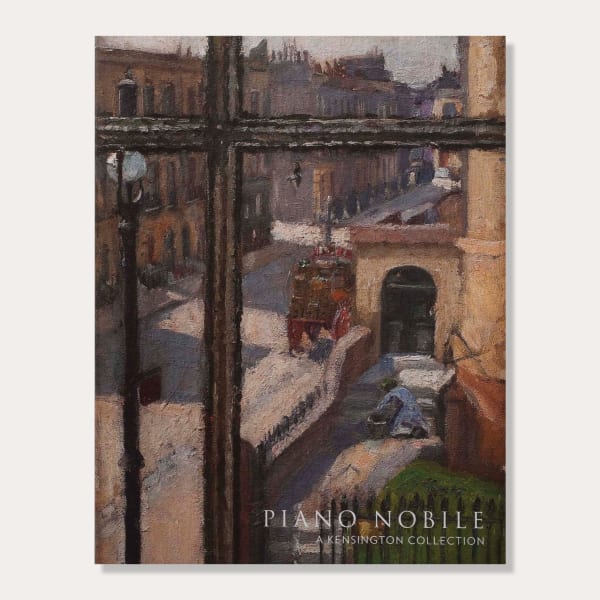
Piano Nobile: A Kensington Collection
2013Booklet, 8 pagesRead more
Publisher: Piano Nobile Publications
Dimensions: 15 x 20 cm -

20th Century Modern British Art
Developments in Modern British Art 2013Booklet, 8 pagesRead more
Publisher: Piano Nobile Publications
Dimensions: 15 x 20 cm -
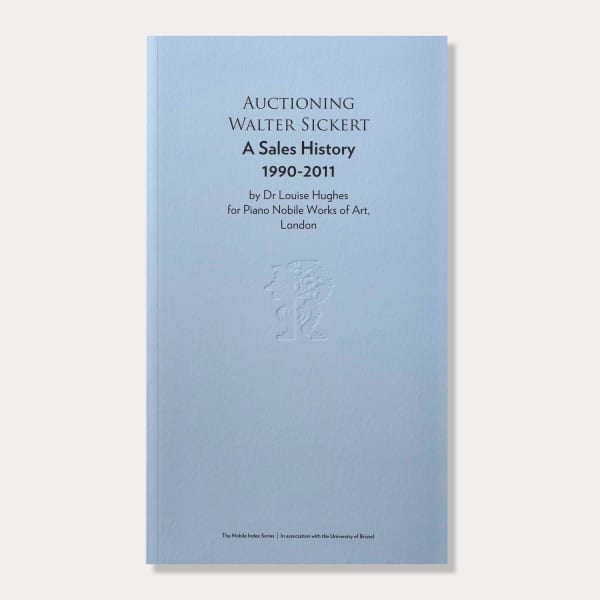
Auctioning Walter Sickert
A Sales History 1990-2011 Dr Louise Hughes, 2012Sewn paperback, 36 pagesRead more
Publisher: Piano Nobile Publications
Dimensions: 16 x 28 x 1 cm -
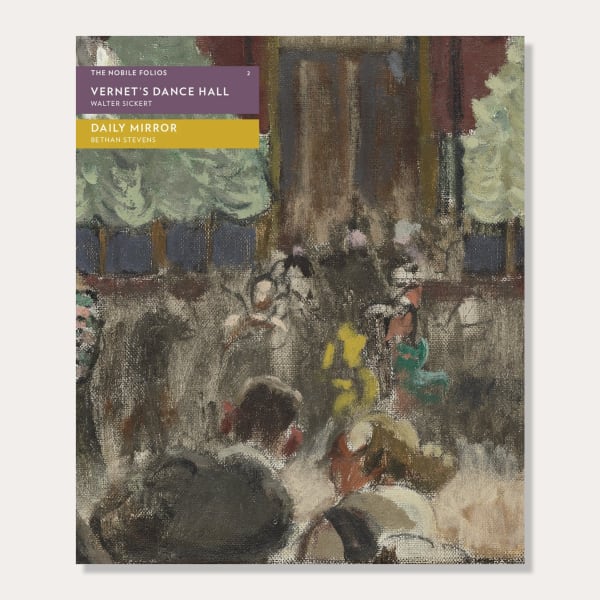
Vernet's Dance Hall Walter Sickert
Set Alongside 'Daily Mirror' Wendy Baron, Bethan Stevens, 2011Sewn paperback, 32 pagesRead more
Dimensions: 239 x 282mm -

Spencer Gore & his Circle
With a special focus on John Doman Turner Foreword by Denys J Wilcox, 1996Softback, 44 pagesRead more
Publisher: Piano Nobile Publications
ISBN: 1901192008
Dimensions: 21 x 28 x 0.5 cm
-

Treasure House Fair
Royal Hospital Chelsea 22 - 26 Jun 2023 Art FairThe Treasure House Fair is a celebration of outstanding and rare art and antiques. Held at The Royal Hospital Chelsea the fair continues the tradition of its predecessors, Masterpiece and...Read more -

A Celebration of Portraiture
Twentieth-Century Britain 5 Jun - 31 Jul 2023 Piano NobileA Celebration of PortraitureRead more
Portraits from Twentieth-Century Britain
An exhibition in collaboration with the National Portrait Gallery
-

Masterpiece
Royal Hospital Chelsea 30 Jun - 6 Jul 2022 Art FairPiano Nobile exhibited at Masterpiece Art Fair in 2022, then London's leading art and antiques fair. Highlights from the gallery's stand included significant works by Walter Sickert, Henry Moore, Paul...Read more -

London Art Week
Winter 2021 3 - 11 Dec 2021 OnlineFor London Art Week Winter 2021, Piano Nobile presented an online display of paintings, sculpture and works on paper. Featured artists included Walter Sickert, Barbara Hepworth, William Turnbull, Grayson Perry...Read more -

Sickert
The Theatre of Life 24 Sep - 17 Dec 2021 Piano NobileIn 1934, Virginia Woolf described Walter Sickert as ‘probably the best painter now living in England’. Among the sources of inspiration which sustained him over a long career, none won...Read more -

Drawn to Paper
Calder to Scott 2 Jul - 6 Aug 2021Paper is easily and variously marked. Charcoal and chalk scuff, smudge or slice; pen and ink dash, hatch and stipple; areas of colour shimmer in pastel, glow in gouache or...Read more -

Defining British Art
1910 - 2000 17 May - 23 Jul 2021 Piano NobileThis exhibition reviewed the major creative outbursts in twentieth-century Britain, with paintings, sculptures, ceramics and textiles made by four generations of pioneering artists – from Sickert at the fin de...Read more -

Drawn to Paper
Degas to Rego 24 Jun - 24 Jul 2020In 2020 Piano Nobile presented Drawn to Paper: Degas to Rego , an online exhibition which showcased works on paper by some of the leading figures of European modernism. The...Read more -

Masterpiece
Online Viewing Room 22 - 28 Jun 2020Highlights from our online display included work by Ben and Winifred Nicholson, William Turnbull, Leon Kossoff, Frank Auerbach, William Crozier, David Bomberg, Lucian Freud and Barbara Hepworth . Also on...Read more -

British Art Fair
Saatchi Gallery 20 - 23 Sep 2018 Art FairPiano Nobile presented a selection of Post-War and Modern British art, including works by Craigie Aitchison, Kenneth Armitage, David Bomberg, Peter Coker, William Crozier, Leslie Marr, Leon Kossoff, Paul Nash,...Read more -

Masterpiece
Royal Hospital Chelsea 28 Jun - 4 Jul 2018 Art FairPiano Nobile presented a selection of Modern and Contemporary British and International artists including works by Anthony Caro, Leon Kossoff, Euan Uglow, Paul Nash, Mark Gertler, William Crozier, Craigie Aitchison...Read more -

Masterpiece
Royal Hospital Chelsea 27 Jun - 5 Jul 2017 Art FairThe gallery presented a selection of Modern and Contemporary British and International artists including works by William Scott, Tracey Emin, Lucian Freud, Augustus John, Duncan Grant and Vanessa Bell, Eduardo...Read more -

Masterpiece
Royal Hospital Chelsea 28 Jun - 6 Jul 2016 Art FairPiano Nobile returns to Masterpiece for 2016 with Modern British, International and Contemporary art for sale.Read more -

20th Century British Art
Developments in Modern British Art 20 Jun - 20 Jul 2013 Piano Nobile20th Century: Modern British Art - Developments in Modern British ArtRead more
Piano Nobile Gallery
Summer show with selected works following the developments in 20th Century British Art
-

Piano Nobile
A Kensington Collection 20 Jun - 20 Aug 2013 Piano NobilePiano Nobile works with several artist's estates and collections, both public and private. In 2013 we were pleased to bring to the market, to be sold as a group or...Read more -

Masterpiece
Royal Hospital Chelsea 28 Jun - 4 Jul 2012 Art FairThe Gallery presented a selection of work by European Modernists including Walter Sickert, Christopher Wood, Hans Hartung, Anthony Caro and William Turnbull.Read more
-

InSight No. 125
Walter Sickert | St Rémy: Chevet de l'Eglise May 19, 2023For Walter Sickert, a little spring sunshine was a fine thing and not to be wasted. Deep shadows helped him to suggest the brightness of...Read more -

A Long Look
Camden New Journal September 1, 2022Alongisde a review of Tate Britain's Walter Sickert exhibition John Evans of the Camden New Journal anticipates Piano Nobile's autumn Frank Auerbach exhibition.Read more -

London Review of Books reviews Walter Sickert The Theatre of Life
London Review of Books, Vol. 44. August 18, 2022Tom Crewe, writer and editor of the London Review of Books, reviews Piano Nobile's publication SICKERT : The Theatre of Life in his recent article...Read more -

Tate's Sickert exhibition supported by Piano Nobile
London April 5, 2022Tate Britain's retrospective of Walter Sickert is supported by Piano Nobile. Running from April to September, the exhibition will be the first large-scale retrospective of...Read more -

Dulwich exhibition includes Piano Nobile loans
London April 4, 2022A new exhibition at Dulwich Picture Gallery includes loans arranged by Piano Nobile. Reframed: The Woman in the Window takes a thematic approach to its...Read more -

The Spectator
Foreign Parts December 4, 2021Martin Gayford reviews Sickert: The Theatre of Life in The Spectator. Describing the exhibition as 'a superb mini-retrospective of an impeccably cosmpolitan artist.'Read more -

Apollo
The Camden Town Group December 4, 2021Emma Crichton Miller reviews Sickert : The Theatre of Life for Apollo Magazine.Read more -

The life-long genius of Sickert
The Critic November 25, 2021'Piano Nobile have succeeded in bringing together a veritable cornucopia of Sickert’s works from private and institutional collections, and in making ridiculous the division between...Read more -

Times Literary Supplement
For paint's sake November 12, 2021Times Literary Supplement reviewed SICKERT The Theatre of Life. 'When Sickert beams his attention on a human singularly - be this a skeletally haggard old...Read more -

InSight No. 89
Walter Sickert | Nuit d'Été, circa 1906 November 10, 2021In this final instalment focusing on Sickert, InSight compares one of his most significant nudes with paintings by his friends, rivals and admirers. Walter Sickert...Read more -

InSight 88
Walter Sickert | This Venice that the Italians called 'Venezia' November 3, 2021This Venice that the Italians called 'Venezia' From Dickens to the prostitutes of Venice, this week InSight delves deeper into the joys and inspirations of...Read more -

InSight 86
Walter Sickert, The New Bedford October 27, 2021Over the next three weeks, to celebrate Piano Nobile's current exhibition SICKERT: The Theatre of Life, InSight delves into the artist's work, highlighting some of...Read more -

The Week
Where to buy... October 16, 2021The Week reviewed SICKERT The Theatre of Life 'Looking at the paintings of Walter Sickert, you feel you almost know the characters who people them:...Read more -

InSight No. 82
Walter Sickert | The Integrity of Belgium, 1914 September 22, 2021SICKERT: THE THEATRE OF LIFE opens at Piano Nobile this week. InSight focuses on a highlight from the exhibition, a war-time masterpiece from 1914. Walter...Read more -

Antiques Trade Gazette
Features SICKERT | The Theatre of Life September 20, 2021The ATG have highlighted Piano Nobile's Autumn exhibition, SICKERT The Theatre of Life. For the full article, see the link below.Read more -

InSight No. 81
Walter Sickert | Portrait of Mrs Barrett, 1906 September 15, 2021Ahead of Piano Nobile’s major exhibition opening next Thursday, SICKERT: The Theatre of Life, InSight considers one of Sickert’s earliest models from his important Camden...Read more -

InSight No. 4
Egdar Degas | Walter Sickert April 6, 2020InSight No. 4 Edgar Degas | Walter Sickert Danseuse vue de dos: Port de bras , c. 1875-85 | Little Rachel , c. 1906 Shortly...Read more -

Piano Nobile loans work to Pallant House Gallery exhibition
Chichester July 4, 2015Piano Nobile loans Walter Sickert painting to Sickert in Dieppe exhibition at Pallant House Gallery, Chichester.Read more
